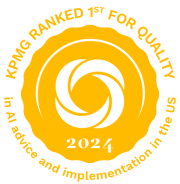Three essentials for effective upskilling, reskilling, and career mobility with AI
Attract and retain top talent with human-centered, always-on learning and development

In the face of AI disruption, cost pressures, and geopolitical uncertainty, many industries are experiencing continual workforce reshaping. To harness these changes effectively, organizations must invest in upskilling and career-mobility programs to attract, grow and retain talent. The workforce of the future can be both human- and AI-centric, which requires learning and development that will not only help your human workforce adapt to job role deconstruction and reconstruction, but will also help enable skills to collaborate with AI systems i.e. digital colleagues.
AI technologies are revolutionizing workforce dynamics, creating exciting opportunities for growth and advancement. However, some employees may be unsure about the pace of change and what it means for their roles. It is essential to demonstrate that AI represents an empowering opportunity not only for business growth, but also for career development. Effective AI upskilling and reskilling programs are key to successfully navigating these workplace changes and helping ensure that both the organization and its employees thrive.
Here are three key factors for developing and sustaining effective upskilling, reskilling, and career mobility with AI:
Essential #1: Keep humans at the center.
AI innovations are advancing rapidly, creating a need for agile and responsive learning models. Even for technology experts, it can be challenging to keep up. Now put yourself in the shoes of non-technical workers who may already feel overburdened with meeting current day-to-day demands. Learning and development need to move at the pace of innovation—while still preserving human-centricity.
Keep these principles in mind when designing AI-centric learning and upskilling programs:
- Make it personal. Tailor learning paths to individual strengths, limitations, interests, and career goals rather than offering one-size-fits-all programs. Give individuals choice and control over what, how, and when they learn. And make sure upskilling opportunities are available to all employees no matter their role, work location, or background.
- Make it safe. Your talent needs to feel emotionally and psychologically safe as they navigate AI and its implications. Create a supportive environment where they feel comfortable experimenting, taking risks, making mistakes, and asking questions.
- Make it daily. In the face of rapid change and innovation, learning and development needs to be baked into daily routines, whether in the form of AI agents who provide information at the point of need or human managers who offer ongoing guidance, mentorship, and coaching.
Fortunately, AI technology is ideally suited to enhancing—rather than replacing—the human connections that fuel engagement and creativity in your workforce. Prioritizing human-centric initiatives empowers your talent with the knowledge, mindset, skills, and experiences they need to thrive in evolving workforce models.
Essential #2: Be intentional about technology.
Traditionally, the learning management system has been the core of most learning and development programs. Yet legacy technology stacks may not fully support the shift to a skills-based talent strategy. Organizations may need to identify and invest in technology tools that help deconstruct roles into skills, so human resources leaders can begin to identify and bridge skill gaps across the organization.
Equally important is the ability to forecast skills the organization will need in the future, as such insights are crucial in shaping upskilling efforts. Consider emerging skills—and prioritize them for upskilling to ensure your workforce is capable of meeting future challenges.
Utilize technology for skills-based learning in the following ways:
- Evaluate current tools: Assess if your existing learning management systems support a skills-based approach.
- Trusted AI Enabled Solutions: Implement AI-driven platforms that offer real-time insights and predictive analytics to forecast future skill needs.
- Integrate smoothly: Ensure new technologies integrate with existing systems to provide a cohesive learning experience.
Essential #3: Embrace continuous learning at the speed of light.
Traditional, one-off training modules must give way to a new operating model that fosters continuous and adaptive learning. The future of learning lies in integrating education into the flow of work—enabling employees to access training and information as they need it. For many organizations, this will involve migration from traditional learning experiences to AI-driven learning experiences that are on-demand and personalized.
Components of continuous learning should include:
- On-demand training: AI-powered systems can provide employees with the precise training they need when they need it.
- Adaptive learning paths: Personalized learning journeys adapt to individual progress and evolving skill requirements.
- Feedback loops: Continuous feedback mechanisms ensure learning is relevant and effective.
Turn AI upskilling into a strategic advantage
Investing in AI-powered and AI-focused learning and development can unleash entirely new pathways for growth and development, giving your organization a significant edge in the battle for talent. By leveraging external data to understand broader industry trends affecting talent availability, tenure, and demand for critical skills, companies can ensure they are equipped with the right mix of human and digital talent. This approach leads to more accurate forecasting and strategic decision-making, allowing organizations to thrive in a rapidly changing environment.
Our approach for AI-driven workforce optimization
As organizations navigate the complexities of AI integration, KPMG offers human-centered solutions that address workforce challenges and help futureproof operations. We help ensure your learning and development programs are aligned with your overall business strategy and technological maturity.
Our capabilities include:
- Skill-Gap Analysis: Utilizing proprietary AI tools, organizations can analyze and identify skill gaps as they arise.
- Trusted AI-Enabled Learning Systems: By implementing advanced AI-powered training platforms, learning experiences are personalized and provide real-time feedback.
- Tailored Upskilling Programs: Customized upskilling and reskilling programs designed to organizations’ unique needs and goals.
- AI Value Realization: Targeted strategies to help manage change effectively, so organizations can foster a culture that embraces AI and continuous learning and upskilling.
The next era of workforce strategy is here with learning as a service
Workforce and talent teams are navigating increasing complexities as organizations strive for faster innovation and greater value. KPMG’s Human Capital Advisory team uses proprietary insights and advanced AI tools to assess talent opportunities and optimize skill deployment, ensuring the right mix of digital and human capabilities to support sustainable growth in today’s dynamic business landscape.

KPMG ranks #1 for quality AI advice and implementation in the US
According to senior buyers of consulting services who participated in the Source study, Perceptions of Consulting in the US in 2024, KPMG ranked No. 1 for quality in AI advice and implementation services.
Insights to help you elevate your workforce operations
What sets apart good from great workforce leaders? It's their ability to harness innovative technology to drive efficiency and foster growth.
Popular category topics
Begin Your Journey Towards Maximizing AI-Driven Workforce Innovation with KPMG
As organizations continue their AI journeys, KPMG LLP (KPMG) offers a human-centered solution to help address workforce challenges and futureproof operations. Our tailored approach helps ensure your workforce, operating model, and technological maturity are precisely aligned. From identifying AI-enablement opportunities to integrating digital workers and reshaping roles, we help you achieve sustainable success.e.
Our proprietary workforce insights model and agentic-AI tools enable organizations to implement advanced workforce planning strategies effectively. Customized AI agents harness robust datasets to provide actionable intelligence, helping companies conduct talent opportunity and deployment assessments and securing the right mix of digital and human skills to meet their strategic needs.
Enable your organization with KPMG AI Workforce >
Unlock AI Workforce Opportunities
Identify and capitalize on AI opportunities across the entire workforce, including human and digital labor. We help ensure your organization maximizes efficiency and productivity by maximizing the impact of AI.
Redesign Jobs and Roles with AI
Take a human-centered approach to redesigning jobs, roles, and occupations to help maximize the impact of AI. Our experts help reimagine your workforce structure so that human and digital workers can effectively capitalize on each other's strengths for optimal performance.
Drive AI Engagement and Adoption
Activate change at all organizational levels, building awareness, understanding, and commitment to incorporating AI into daily work processes. We help create a culture that embraces AI, enhancing collaboration between human employees and AI agents.
Enhance AI Learning and Development
Deliver role-specific AI and Generative AI learning programs, continuously updated to equip your workforce with the latest skills and knowledge. Our tailored training helps ensure your employees stay ahead of the curve in a rapidly evolving digital landscape.
Subscribe to Human Capital Real Insights: Delivering in today's world of work
Subscribe to Human Capital Real Insights for access to research, analysis, and events to help you gain strategic insight and position your enterprise for a competitive advantage.
Meet our team
The KPMG Human Capital Advisory team helps organizations implement advanced workforce strategies by leveraging our proprietary workforce insights model and AI tools. Teaming with KPMG helps ensure that organizations can effectively conduct talent opportunity and deployment assessments, securing the right mix of digital and human skills to meet current strategic needs and realize sustainable growth.





